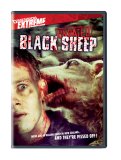When picking up a copy of Jonathan King’s Black Sheep, you know exactly what you are getting into: a lot of bloodthirsty sheep. For about 83 minutes, the film delivers exactly what is promised on the front cover. That being said, the film is definitely catered to a rather specific audience, consisting of people who would actually want to watch Black Sheep. However, hiding under the implied lunacy, is a rather intelligent pastiche of the genre tropes put forth by its many predecessors.
King’s directorial debut focuses on the Oldfield brothers, Henry (Nathan Meister) and Angus (Peter Feeney). Still traumatized by a childhood incident involving his pet lamb, Henry (now terrified by sheep) returns home to sell Angus his inheritance of the farmland, in hopes of leaving his trauma behind him. Unbeknownst to Henry, Angus has turned the once beautiful farm into a laboratory dedicated to genetically modifying the DNA of sheep.
While revisiting other memories of the farm, he meets Experience (Danielle Mason), an animal activist whose partner went missing after unwittingly releasing one of the genetic monstrosities onto the grounds. As the new DNA spreads through the grounds, the sheep become hostile, and the humans become, well, sheepish. As the weresheep begin to prowl the area, Henry and Experience continue to exploit the farm’s evil deeds, while Angus stops at nothing to realize his dream of the perfect sheep specimen.
This film hails from a particular movement in cinema I like to call “the attack of the mundane creatures” genre. Though there were a few before it, I like to place the origin of this genre with Alfred Hitchcock’s The Birds (1963). Soon, other “mundane creature” flicks began to surface, only they forgot to add in the masterful suspense Hitchcock put into his work. George McCowan’s Frogs (1973) and William F. Claxton’s classic Night of the Lepus (1972) are two such titles that emphasize the “mundane” nature of the genre.
With Black Sheep, King returns to this genre in 2006, but actually understands the concept of suspenseful filmmaking. The film is classified as a “horror comedy,” but the “horror” is definitely its strong suit. Never have I been so terrified of a sheep staring blankly into a camera. Why? The film provides a combination of tasteful pacing and wonderful practical effects (animatronics and puppets). The concept of typically docile creatures attacking human beings is funny, yes, but the way in which the film was shot begs spectators to take it seriously. Quick edits, shaky cameras, and shadow play all contribute to making the silly concept into well-constructed “monster” scenes in the same vein as Alien (1979) or The Thing (1981).
What takes away from this film is the “comedy” portion. Taking cues from a giant of New Zealand filmmaking, Peter Jackson, King attempts to emulate Jackson’s early, gory films such as Braindead (1992). While he gets the gore correct, every joke put into the dialog really takes away from the beautiful tone created by the aforementioned camera work, set design, and editing. Thankfully, the film’s strengths are greater than its weaknesses; otherwise the film would be kind of hard to sit through. Overall, King is well aware of his craft as an artist, and I would recommend this film to any lover of the horror genre.



